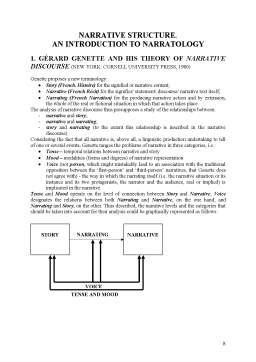Extras din referat
1. GÉRARD GENETTE AND HIS THEORY OF NARRATIVE DISCOURSE (NEW YORK: CORNELL UNIVERSITY PRESS, 1980)
Genette proposes a new terminology:
- Story (French. Histoire) for the signified or narrative content;
- Narrative (French Récit) for the signifier/ statement/ discourse/ narrative text itself;
- Narrating (French Narration) for the producing narrative action and by extension, the whole of the real or fictional situation in which that action takes place.
The analysis of narrative discourse thus presupposes a study of the relationships between:
- narrative and story;
- narrative and narrating;
- story and narrating (to the extent this relationship is inscribed in the narrative discourse).
Considering the fact that all narrative is, above all, a linguistic production undertaking to tell of one or several events, Genette ranges the problems of narrative in three categories, i.e.:
- Tense – temporal relations between narrative and story
- Mood – modalities (forms and degrees) of narrative representation
- Voice (not person, which might mistakably lead to an association with the traditional opposition between the ‘first-person’ and ‘third-person’ narratives, that Genette does not agree with) - the way in which the narrating itself (i.e. the narrative situation or its instance and its two protagonists, the narrator and the audience, real or implied) is implicated in the narrative.
Tense and Mood operate on the level of connection between Story and Narrative; Voice designates the relations between both Narrating and Narrative, on the one hand, and Narrating and Story, on the other. Thus described, the narrative levels and the categories that should be taken into account for their analysis could be graphically represented as follows:
1. ORDER
Genette proposes to study the relations between it and the time of the story according to three essential determinations:
1. “connections between the temporal order of succession of the events in the story and the pseudo-temporal order of their arrangement in the narrative”;
2. connections of speed between “the variable duration of these events or story sections and the pseudo-duration (in fact, length of the text) of their telling in the narrative”;
3. “connections of frequency, that is ( ) relations between the repetitive capacities of the story and those of the narrative.” (35)
To describe the “various types of discordance between the two orderings of story and narrative” that might be conceived as deviations from a so-called, rather hypothetical, zero degree “that would be a condition of perfect temporal correspondence between narrative and story” (36), Genette proposes the term of anachrony and distinguishes between the following:
- prolepsis = “any narrative maneuver that consists of narrating or evoking in advance an event that will take place later” (40)
- analepsis = “any evocation after the fact of an event that took place earlier than the point in the story where we are at any given moment” (40)
Genette also maintains that, by establishing a so-called “first narrative,” i.e. “the temporal level of narrative with respect to which the anachrony is defined” (48), it is possible to distinguish between:
- external analepsis = “this analepsis whose extent remains external to the extent of the first narrative.” (49)
- internal analepsis
- mixed analepsis = “whose reach goes back to a point earlier and whose extent arrives at a point later than the beginning of the first narrative.” (49)
According to Genette, the categorisation of analepses should not be limited to this distinction, but should be developed so as to clearly indicate the differences between two types of internal analepses. On the one hand, there are those called heterodiegetic, “that is analepses dealing with a story line (and thus with a diegetic content) different from the content (or contents) of the first narrative.”(50) They classically deal either with a character recently introduced whose past the narrator wants to shed more light on or with a character that has been out of sight for some time and whose past the readers must catch up with. On the other hand, there are also internal homodiegetic analepses that deal with the same line of action as the first narrative and for which the risk of interference is apparently unavoidable. (50-1)
Like analepses, prolepses can be categorized, considering the same criteria, as internal and external, homodiegetic and heterodiegetic.
Preview document
Conținut arhivă zip
- Narrative Structure - An Introduction to Narratology.doc

















